Production of Atmospheric Turbulence
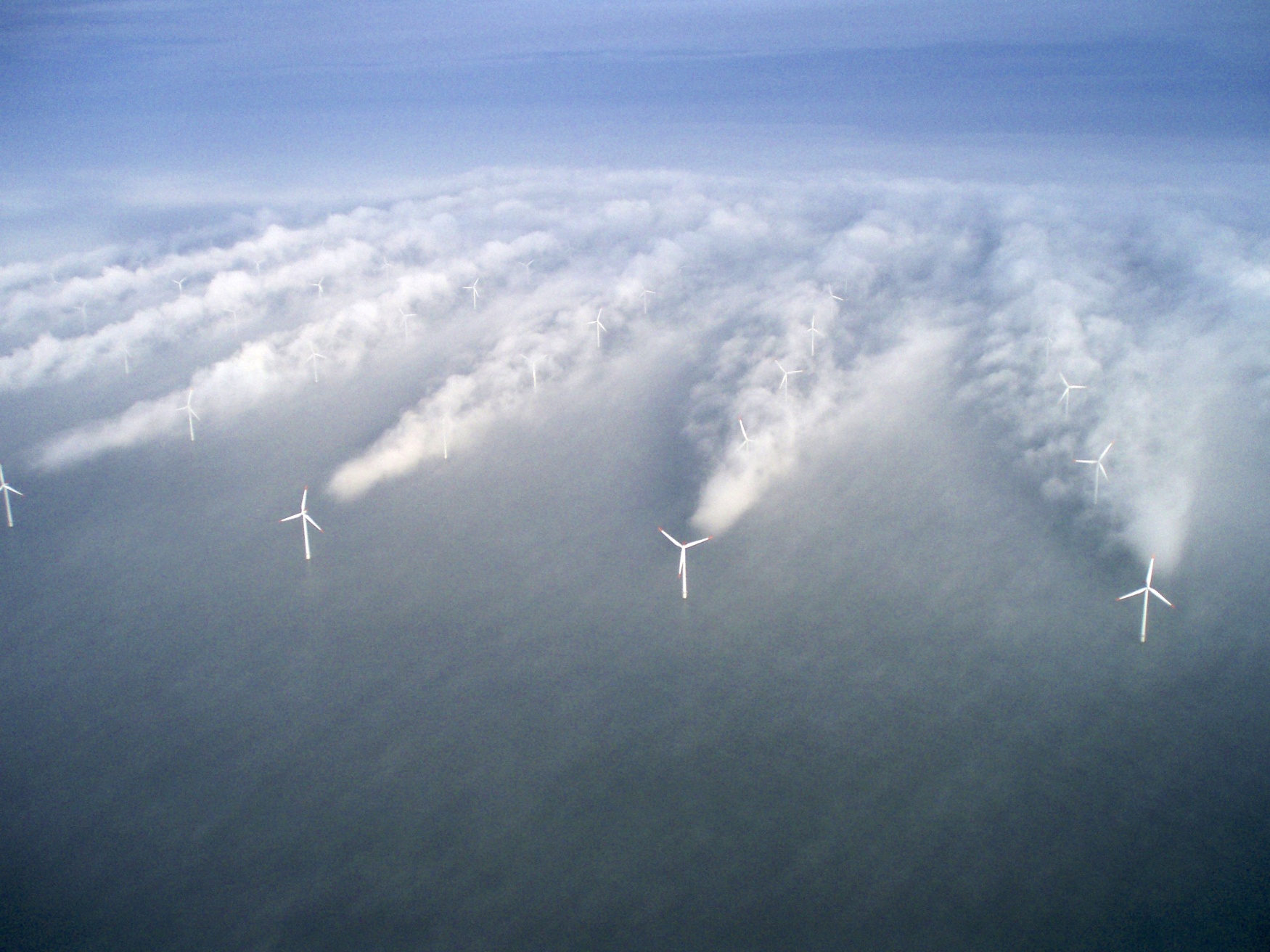
Turbulence and mixing behind wind turbines (Christian Steiness)
Today’s learning objectives
- Describe how, when and where is turbulence produced in the atmospheric boundary layer.
- Explain where the energy for turbulent motions comes from.
- Explain whether the characteristics of a turbulent flow depend on the processes causing them.
Midterm (iClicker)
Will today’s material be on the mid-term?
- A - Yes
- B - No
Reynold’s number (Re)
- There is a critical point in fluid flow when well-behaved laminar flow breaks down into turbulent ‘chaos’.
- Depends on ratio of inertial forces (associated with horizontal motion in fluids) to the viscosity of the fluid:
\[ Re = \small\frac{ud}{\upsilon} \]
- u - characteristic velocity of the fluid
- d - characteristic length scale
- \(\upsilon\) - kinematic viscosity (includes density)

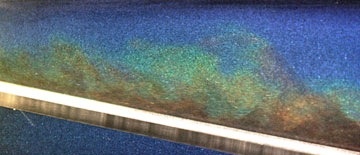
Reynold’s number (Re)
A dimensionless threshold to define whether the flow is turbulent or laminar.
Conceptually, \(Re\) is defined as the ratio between inertial and viscous forces (inertial forces are associated with the mean motion of the fluid and the viscous forces are associated with frictional shear stress.)
The threshold for the onset of turbulence is about 2000. I.e., turbulence is associated with large Reynolds numbers. Most atmospheric flows are turbulent (Re >> 2000) as \(\upsilon\) is on the order of 10^{-5} m^2 s^{-1}, d is 100s of meters and u is on the order of 0.1 to 10 m s^{-1}.
- In other words, the characteristic length scale of the flow is much larger than the thickness of the laminar boundary layer
\(Re\) for wind blowing 0.25 m s^{-1} over a 10 cm leaf is 250.
Reynold’s number - Examples
Daytime atmospheric boundary layer (ABL):
\(Re = \small\frac{ud}{\upsilon}=\small\frac{10 ms^{-1} * 1000m}{1.51^{-5}m^{2}s^{-1}} = 6.6*10^8\)
Model in a wind tunnel:
\(Re = \small\frac{ud}{\upsilon}=\small\frac{1.5 ms^{-1} * 0.3m}{1.51^{-5}m^{2}s^{-1}} = 3.0*10^4\)
- \(Re_{crit} \approx 10^6\) in real atmospheric flows, \(Re_{crit} \approx 2 * 10^4\) in engineering flows.
- But Re is of limited value in real atmospheric flows because of role of buoyancy (that increases or decreases the amount of turbulence).
Production of turbulence
Turbulence in the ABL is a ‘mixture’ of mechanical (forced) and thermal (free) convection.
Mechanical turbulence in the ABL is caused by instabilities arising from strong mean velocity gradients, which in turn are caused by surface skin or form drag (obstacles) or shear flow.
Skin drag
In micrometeorology and climatology we encounter fully adjusted wall-bounded flows with the surface as the lower boundary condition.
A strong velocity gradient is caused due to the no-slip condition at solid boundaries - skin drag. This velocity gradient becomes unstable when reaching higher Re.
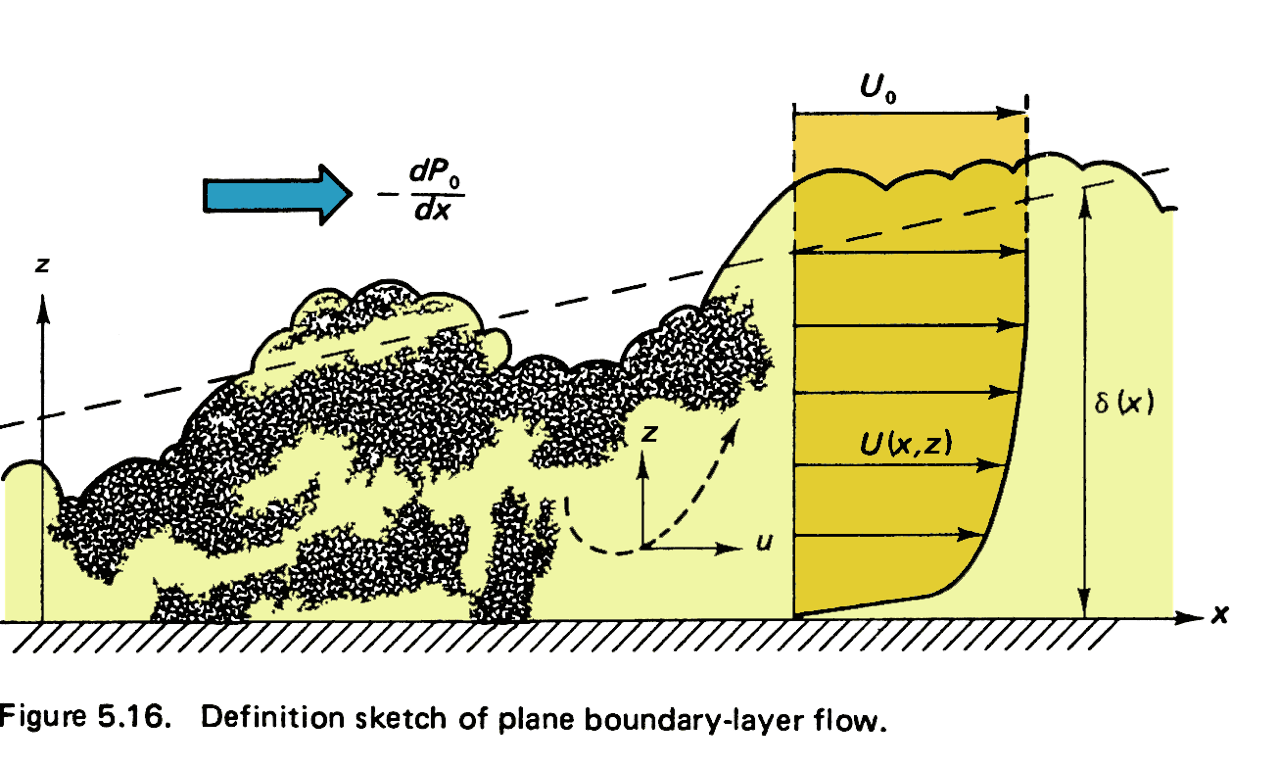
Form drag
Obstacles in the flow (trees, houses, etc.) cause separation and pressure differences giving eddies in the wake.

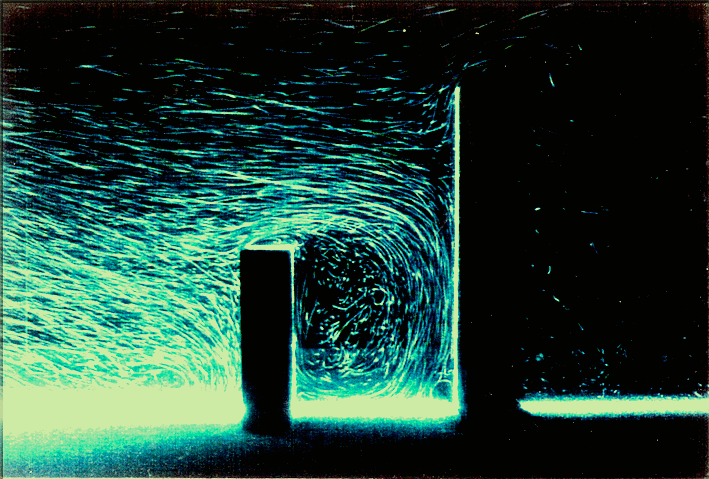
Mechanical (forced) convection caused by an obstacle
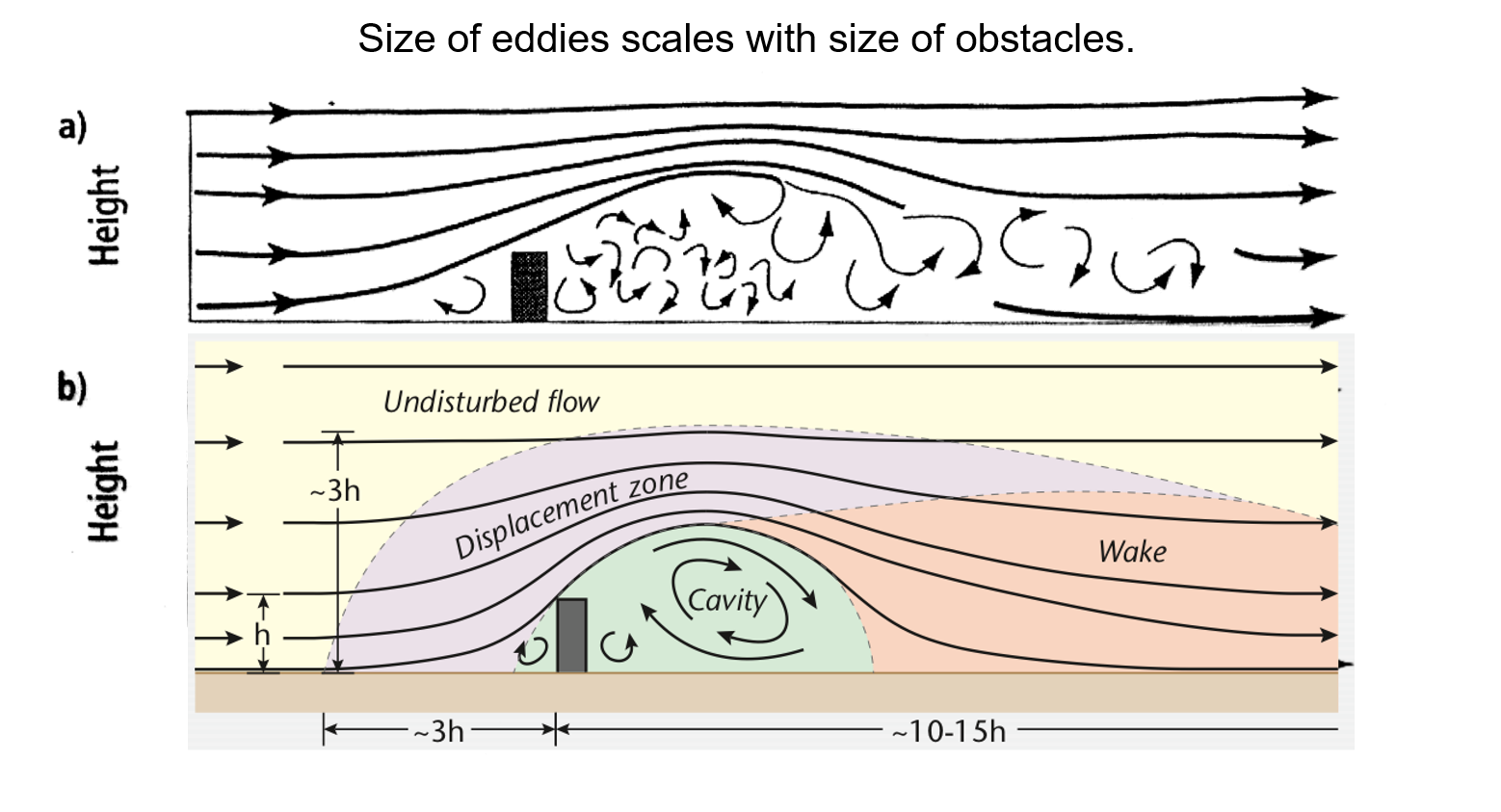
Size of eddies scales with size of obstacles.
Air flow around buildings
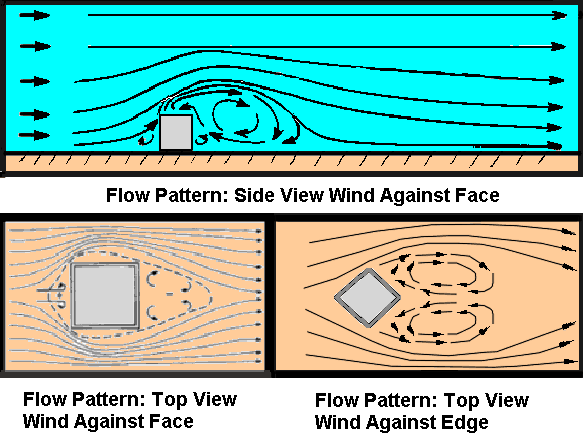
T.R. Oke (1987): ‘Boundary Layer Climates’ 2nd Edition.
Practical Application: Aviation

Airplanes wings work by exploiting pressure differentials due to flow separation to produce lift!
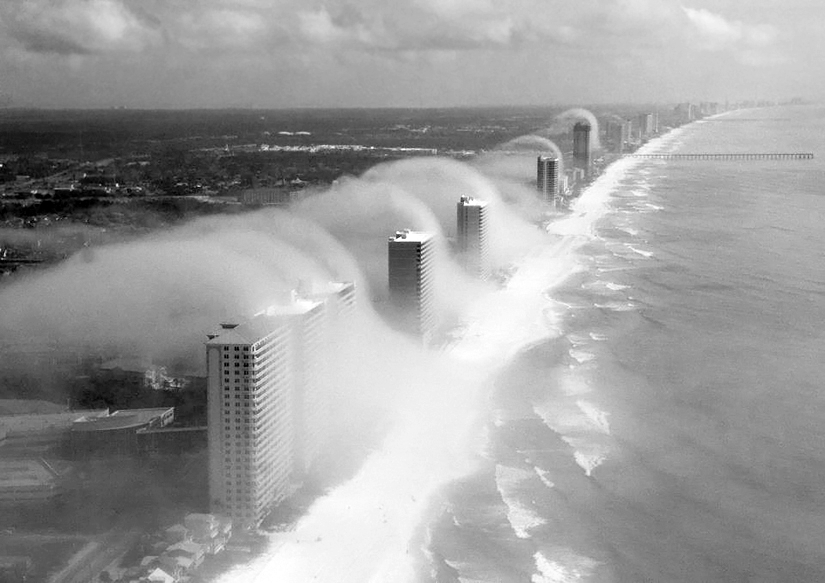
Clouds over high-rise buildings in Panama City Beach, Florida, USA. Wind is from the right (ocean). (Photo courtesy of J. R. Hott, Panhandle Helicopters).
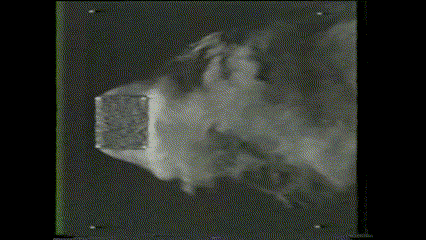
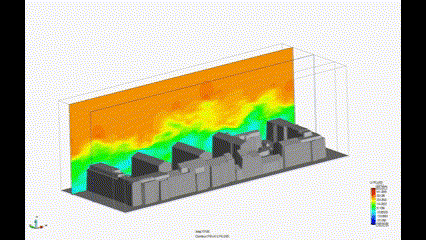
Simulation of turbulence above a city block using a numerical model (Courtesy of M. Parlange / M. Giometto, UBC)
Mechanical (forced) convection due to shear

Direct numerical simulation of turbulence in a Kelvin Helmholtz instability
Kelvin Helmholtz waves in BC
These can produce interesting cloud features in areas of complex terrain.
- They even make it on to local news, like this example from November 2023
Mechanical (forced) convection
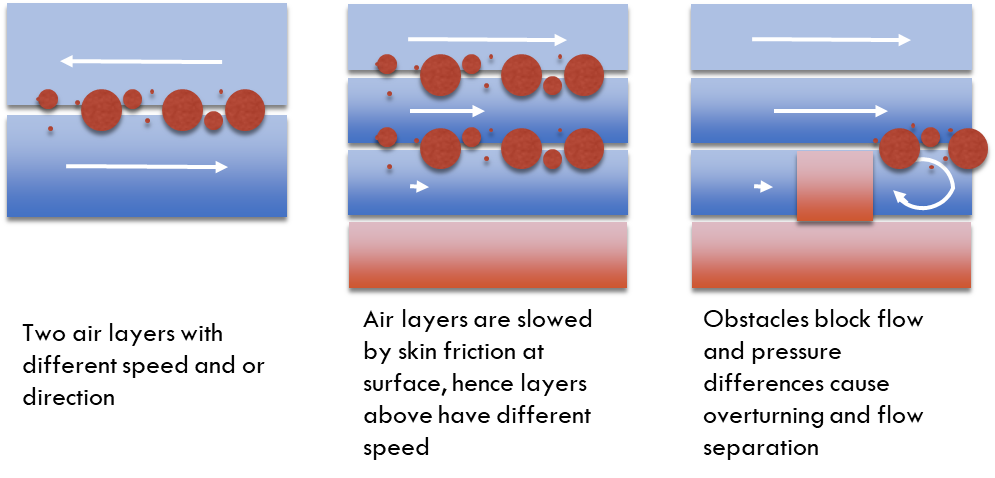
We can have three different scenarios that create turbulence mechanically
Thermal (free) convection

Thermal (free) convection
- Surface heating → density differences in air → convective exchange due to buoyancy.
- Thermal turbulence production requires continual input of heat which is converted to turbulent kinetic energy.
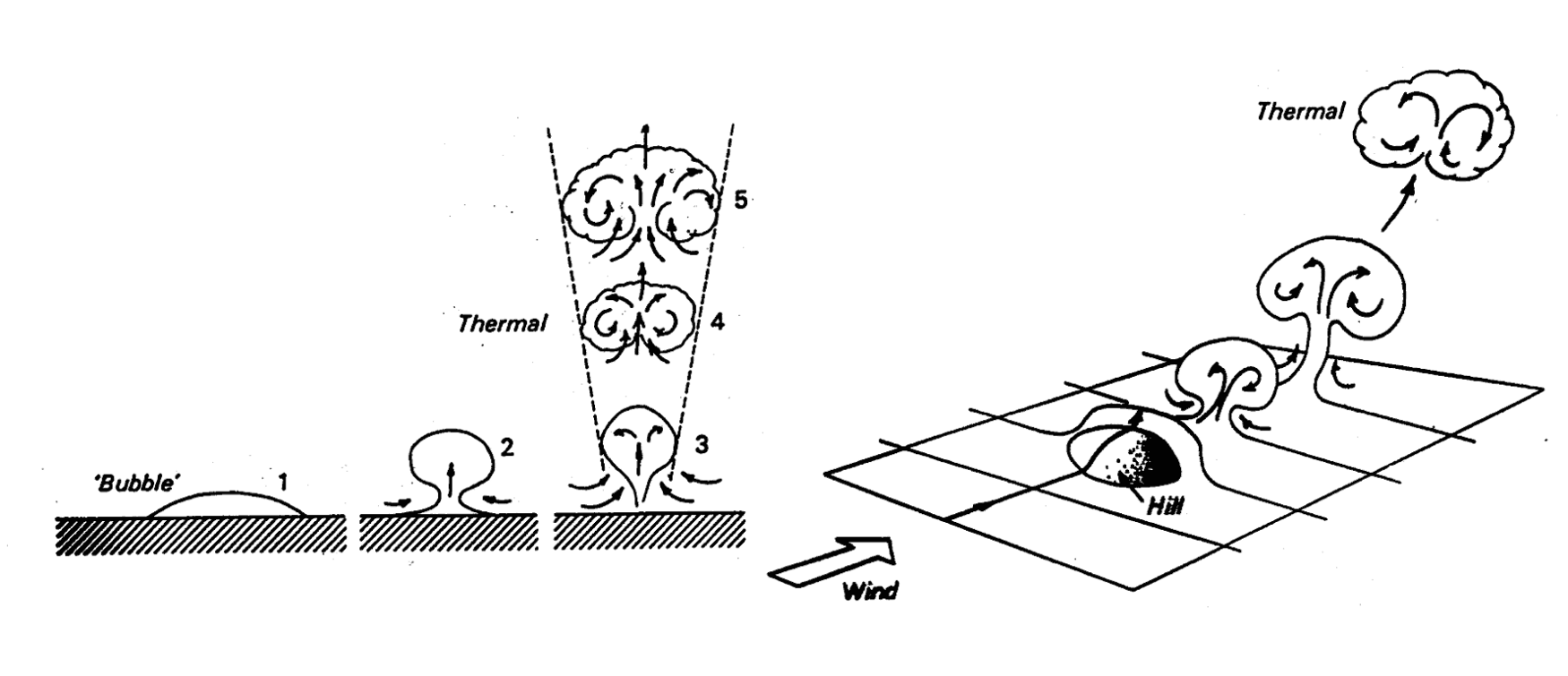
T.R. Oke (1987): ‘Boundary Layer Climates’ 2nd Edition.
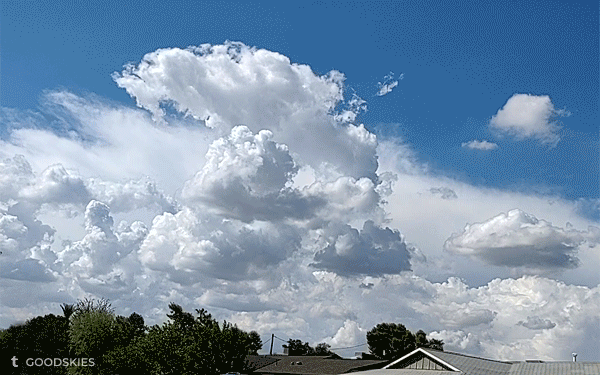
Intense Convection > Thunderstorm
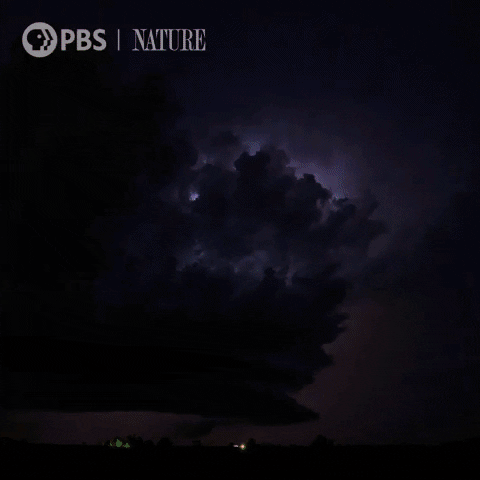
Thermally produced turbulence - free convection
- Size of eddies scales are restricted by the height of the atmospheric boundary layer (ABL)
- The height of the ABL depends on the profile of potential temperature which in turn is controlled by turbulent mixing
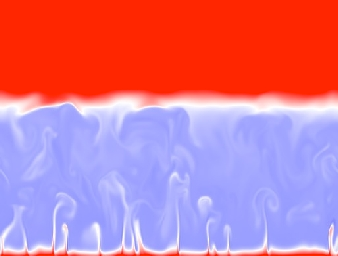
Thermally produced turbulence - free convection
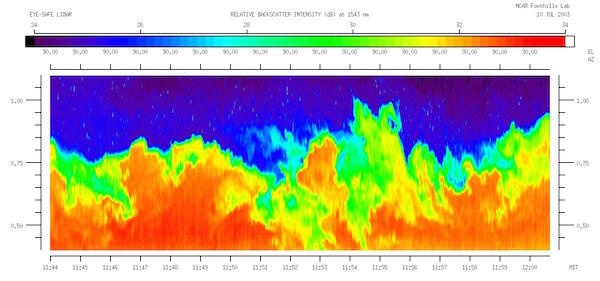
Lidar image is a vertical slice through the atmospheric boundary layer, where polluted airis being carried upward from the surface by thermals Source
Measuring thermal turbulence on an aircraft
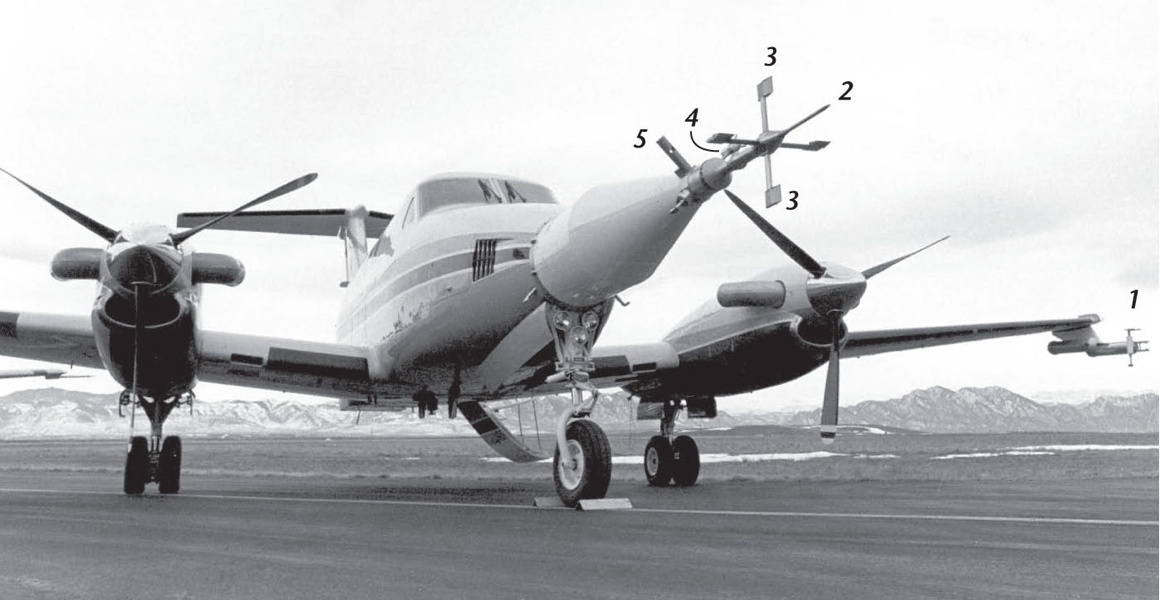
Thermal (free) convection
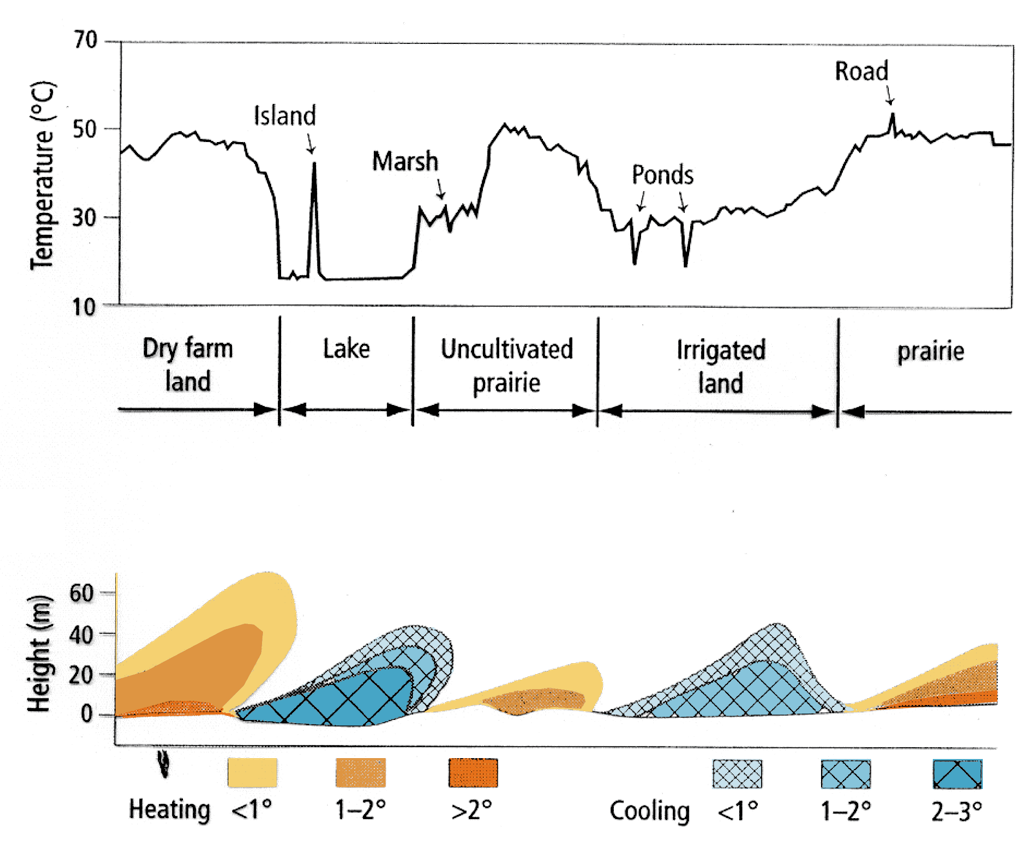
Variations across the landscape
Mechanical vs. thermal turbulence
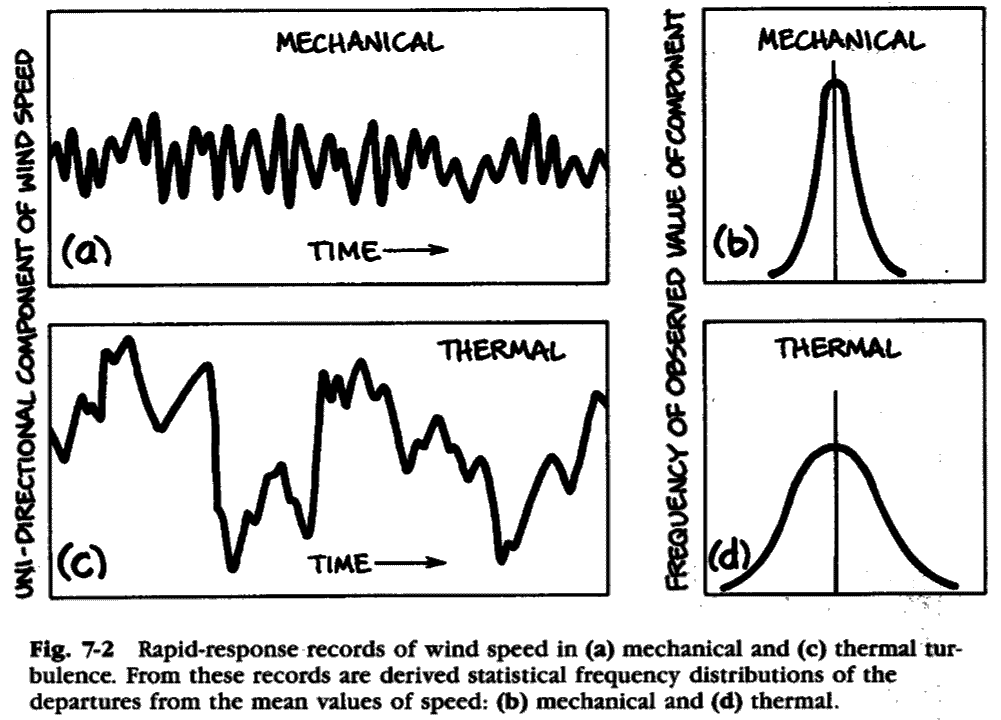
W. P. Lowry, P. P. Lowry (1989)
Thermal convection and suppression
- Unstable: Mechanical (forced) and thermal (free) convection.
- Neutral: Only mechanical (forced) convection.
- Stable: Mechanical (forced) convection and thermal suppression.
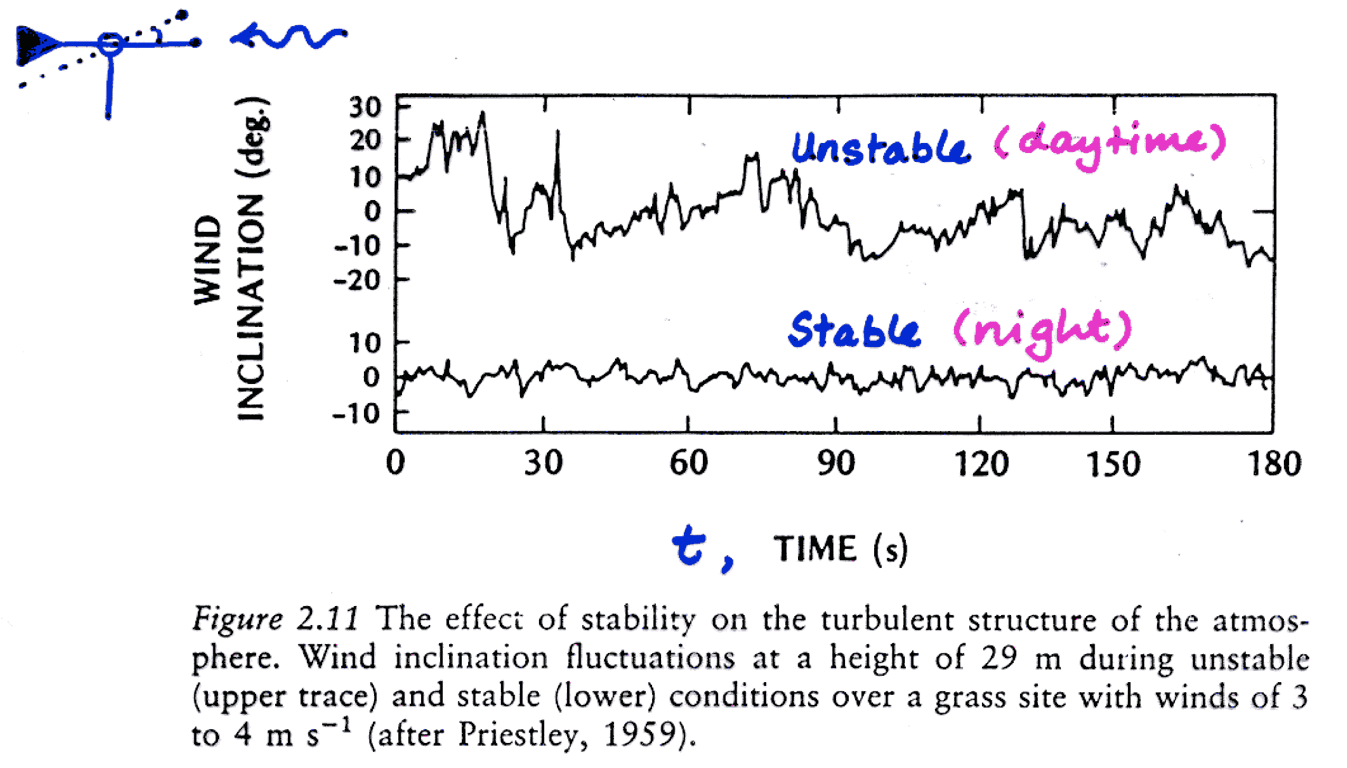
Conservation of energy - The Turbulent Kinetic Energy (TKE) budget
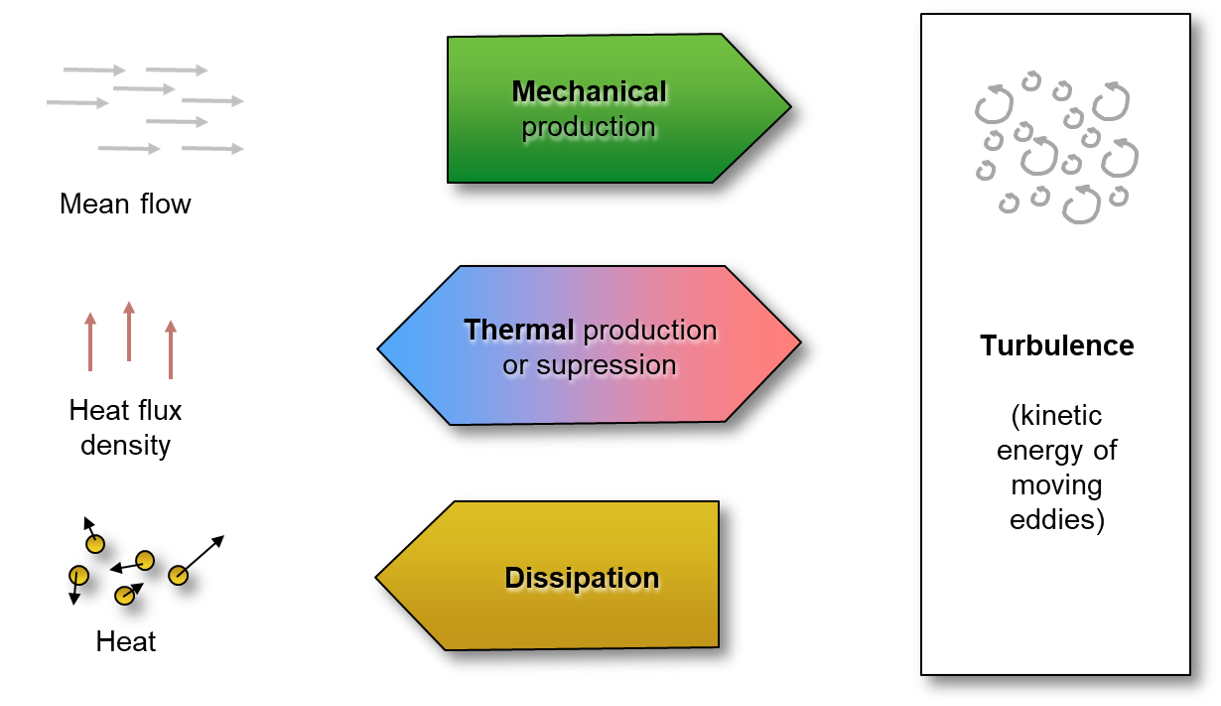
Turbulence (iClicker)
Parcel of cool air moving over a 5 m tall tree canopy at 10 m s-1 on a hot, sunny day would experience:
- A - Mechanical Convection
- B - Thermal Convection
- C - Both!
Take home points
- Turbulence in the ABL is a ‘mixture’ of mechanical (forced) and thermal (free) convection.
- Mechanical turbulence in the ABL is caused by instabilities arising from strong mean velocity gradients, which in turn are caused by surface skin or form drag (obstacles) or shear flow.
- Thermal turbulence is caused by mean velocity gradients between warm air plumes rising up in the ABL which in turn are caused by differential surface heating.
- Mechanical turbulence production requires continual supply of kinetic energy (mean wind) while thermal turbulence requires continual supply of a sensible heat flux (surface heating).